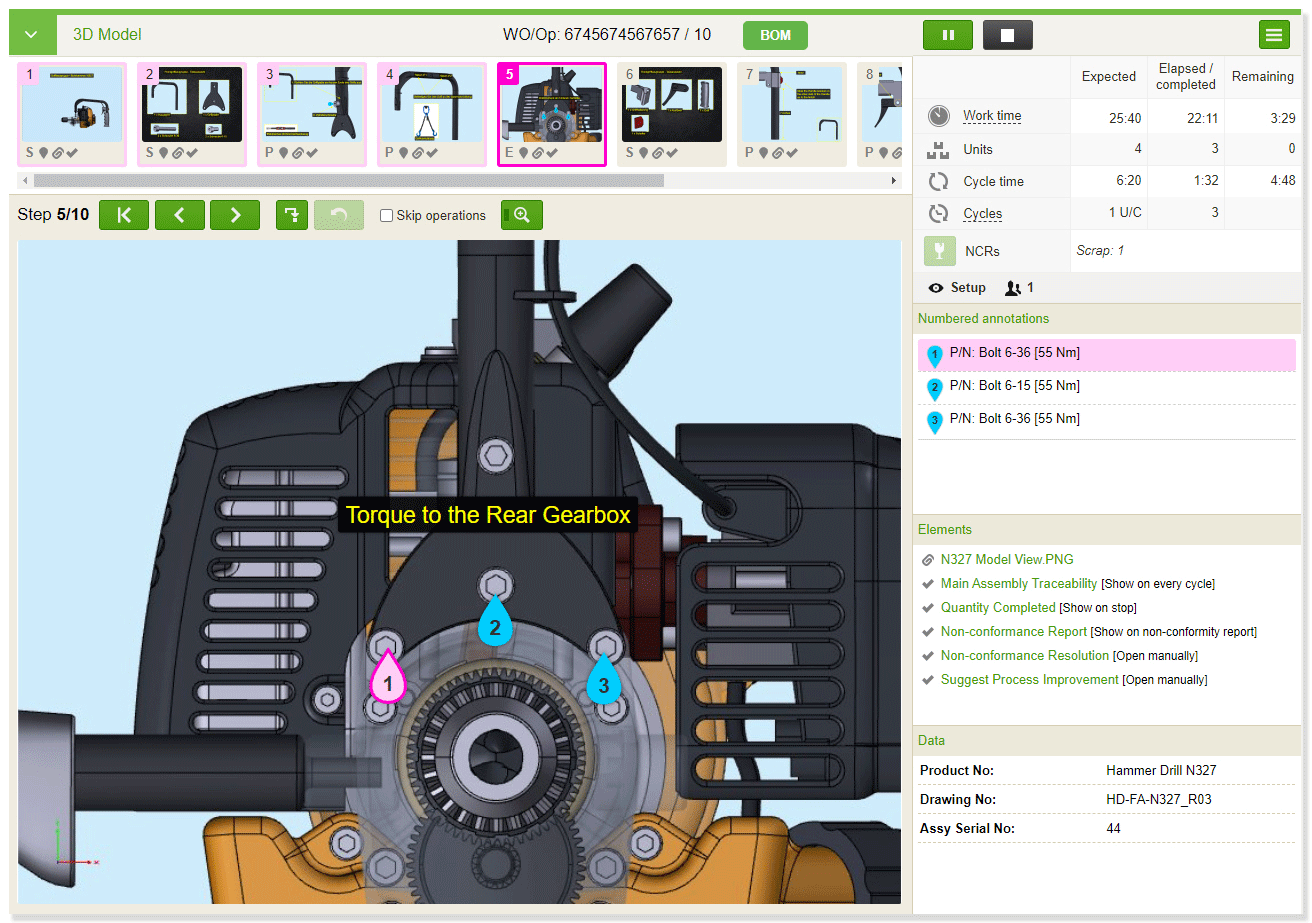Smart tools are an incredible resource for manufacturers. They assist workers with their tasks while gathering massive amounts of data that can be used for quality control and quality assurance.
But how smart are your smart tools?
In reality, smart tools are worthless without a smart system behind them calling the shots. So all error mitigation efforts, productivity-boosting, and automated efforts need to be run by an intelligent and versatile system. And your smart tools process needs to fit the unique requirements of your operation to be useful.
ToolConnect IoT is a perfect example of a smart system that allows manufacturers to streamline their production flow, eliminate defects, and automate processes through intelligent integration with their work instruction software
ToolConnect IoT is a VKS add-on that allows workers to use smart tools with their work instruction software. As the operator follows their step-by-step instructions, ToolConnect IoT and the user’s smart tool are working together to perform the following 4 actions:

Automatically push torque settings to your smart tools: ToolConnect IoT sends the correct torque values directly to your smart tools as you use them. This means that if two bolts require two different torque applications, the smart tool will automatically change the amount of applied force for each one, ensuring that the correct torque is applied every step of the way.
Automatically progress to the next step: When a bolt is tightened within specification, your guidebook will move to the next step. Operators only need to interact with the smart tool, allowing them to achieve a more efficient workflow.
Monitor performance: As operators assemble each product, VKS monitors that the correct torque values were applied in real time. If there is any problem with a fastened bolt, VKS alerts the operator immediately.
Gather valuable data: Whenever a smart tool is used, VKS gathers valuable data for quality assurance that can be passed on to the customer.
To show each of these 4 actions in a real-life scenario, imagine you are an assembly operator building nautical outboard motors. These motors need to be built strong and each bolt needs to be torqued precisely so that the engines can perform their function safely and efficiently.

To make your job easier and more productive, your company has provided you with step-by-step digital work instructions and connected smart tools. Through pictures, videos, and annotations, you know exactly what to do and the best way to do it. When you are on a step with a TC (ToolConnect) annotation, VKS tells the tool what Pset value to apply.
You don’t need to fiddle with any controls, the whole system and data transfer are automated.
At the same time, VKS automatically advances the guidebook to the next step once the correct torque has been applied. For quality control purposes, if you apply the wrong torque pressure for any reason, your work instructions will not allow you to move to the next step.
While you interact with the tool and the automated process, VKS also records the data on each torque assembly, creating a record for quality assurance.
ToolConnect IoT works alongside the operator to perform the incredible feats of automated process flow, intuitive quality control, and data collection.
However, like all good things, there is no limit as to how much we can improve and achieve.
Aside from the ability to streamline information and capture assembly data in real time, ToolConnect IoT has two key features that will interest forward-thinking manufacturers. These are Torque Tool Validation (TTV) and our new Tool Lock feature. Each makes defects a virtual impossibility through advanced process monitoring and operational compliance.
Curious about Psets?
Psets are pre-programmed torque values that guidebook authors select to tell the smart tool how much force to apply to any specific bolt. For instance, Pset 1 applies 15nm of torque while Pset 5 applies 30nm of torque. This is an easy criterion that allows smart tools to understand how much pressure to apply.
Before Torque Tool Validation (TTV), guidebook authors would assign a Pset value to each step requiring a torque tool action. The operator would simply pick up their smart tool and VKS would relay which Pset to use directly to the tool.
While this worked well, it was difficult to validate that the smart tool applied the proper torque, especially if someone else reprogrammed the Pset value without telling anyone.
To eliminate this problem, TTV empowers companies to establish a proper torque range for each fastener in the assembly. VKS monitors the physically applied torque and validates it against the specified range in real time. If the bolt is fastened outside of the specified range, no matter the Pset, the operator is informed immediately. This capability adds another layer of security and error-proofing to your process.

Returning to our nautical outboard motor example, imagine an engineer calculates that a specific 10mm bolt needs 25 nm of force. While creating the process, she programs the guidebook to apply Pset 8 on that bolt. To her knowledge, Pset 3 has been programmed to 25 nm of force. Unbeknownst to her, one of her colleagues has changed Pset 3 to 16 nm for another job, which is not enough torque.
Luckily, she has established TTV within her guidebook. As soon as the smart tool applies 16 nm of force, VKS Torque Tool Validation flags the bolt as a non-conformance and the smart tool signals that the bolt was under-torqued. The operator quickly notices the problem and corrects the error.
In a case without Torque Tool Validation, the operator and the smart tool would be unaware of the potential problem. But now, the process achieves greater levels of error proofing, the operator gains in-the-moment insight, and the smart tool archives greater levels of intelligence.
As we’ve seen, Torque Tool Validation (TTV) enables companies to fortify their error-proofing procedures around smart tools and human processes. VKS Tool Lock takes this even further and eliminates the possibility of human error entirely.
Tool Lock is a ToolConnect IoT feature that prohibits the smart tool from being used on steps that do not require it. At face value, this feature does one of 2 things during assembly:
- If a user is on a step that has a TC annotation, they can use the smart tool and apply the proper amount of force.
- If the user is on a step that does not require a smart tool, VKS sends a signal and locks out the smart tool from being used.

Though potentially a seemingly simple upgrade, Tool Lock ensures that operators do not apply torque on any bolt that has already been fastened while also ensuring that the correct parameters and Pset values are applied every time.
The process needs to be precise and Tool Lock ensures precisely that.
To describe the process in greater detail, ToolConnect IoT, the VKS guidebook, operators, and their smart tools band together to perform the 6 following actions with high levels of precision.
- Once the operator advances to a step with a ToolConnect annotation, VKS unlocks the tool.
- The digital work instructions relay the programmed Pset value for the tool to use.
- The operator fastens the bolt while the tool applies the pre-determined amount of force.
- VKS verifies that the applied torque is within the acceptable range through Torque Tool Validation (TTV).
- Throughout the assembly, the work instruction software gathers data from every action, including all actions performed with a smart tool.
- If the bolt is fastened properly, VKS automatically advances to the next step and the smart tool is locked until it is needed again.
The great thing is that this whole sequence of events occurs within a matter of seconds. And under the guiding principles of Industry 5.0, the operator only needs to interact with the smart tool and monitor their screen.
It's fast, efficient, and most importantly, intelligent.
Let’s return to our outboard motor example. When assembling these nautical motors, different bolts have different torque requirements.
It would be nice if the specifications were the same for every bolt but that’s just not the world we live in.
Some bolts require 35 nm (newton-meters) of force while some bolts require 45 nm of force. Adding to this, assembly consists of a whole lot more than fastening bolts. There are safety precautions, assembly steps, inventory tracking, and more. All of these steps potentially make it difficult for you and your colleagues to keep track of the ins and outs of every process.
However, with the use of digital work instructions, you know that the process is virtually error-proof for 4 distinct reasons.
- The process is completely standardized: VKS guides you through the procedure using easy-to-follow visual and interactive instructions.
- The right torque value is automatically applied: The specified torque value (Pset) is automatically pushed to your smart tool at the moment you need it.
- VKS validates the torque pressure in real time: As soon as the bolt is tightened, VKS verifies that the recorded pressure is within specified limits through Torque Tool Validation (TTV).
- The smart tool is locked when not needed: On steps without a ToolConnect annotation, the tool is locked out so that operator does not mistakenly use it and fasten a bolt with the wrong amount of torque (Tool Lock).
Returning to our nautical motor example, you begin tightening bolts on the 1000 cc motor. You’ve assembled this 1000 cc motor many times and you are fairly confident in your ability to remember the process.
You’ve just tightened a bolt with your smart tool using Pset 4 (35 nm) and you know the next bolt needs to be tightened with Pset 5 (45 nm). Your smart tool will automatically adjust to the new value so you have nothing to worry about and move on to the next bolt.
However, in your excitement to finish the job, you’ve forgotten something.

In between fastening these two bolts, you need to install a metal bracket. This step is critical to product integrity and if missed, would require hours of rework.
You try to tighten the next bolt but the tool is locked out. You look over at your instructions and see why. There’s no TC annotation because you’re not on a step that requires a smart tool. You install the bracket and continue work as planned.
Crisis averted!
Like all good things, teamwork is essential to a thriving manufacturing environment. This is true for people and it is equally true for the systems, machines, and smart tools we use.
Smart tools are only as smart as the systems behind them.
Manufacturers can take advantage of this advanced teamwork to create a strong digital thread that eliminates errors, streamline production, and make your smart tools as smart as they can be.






